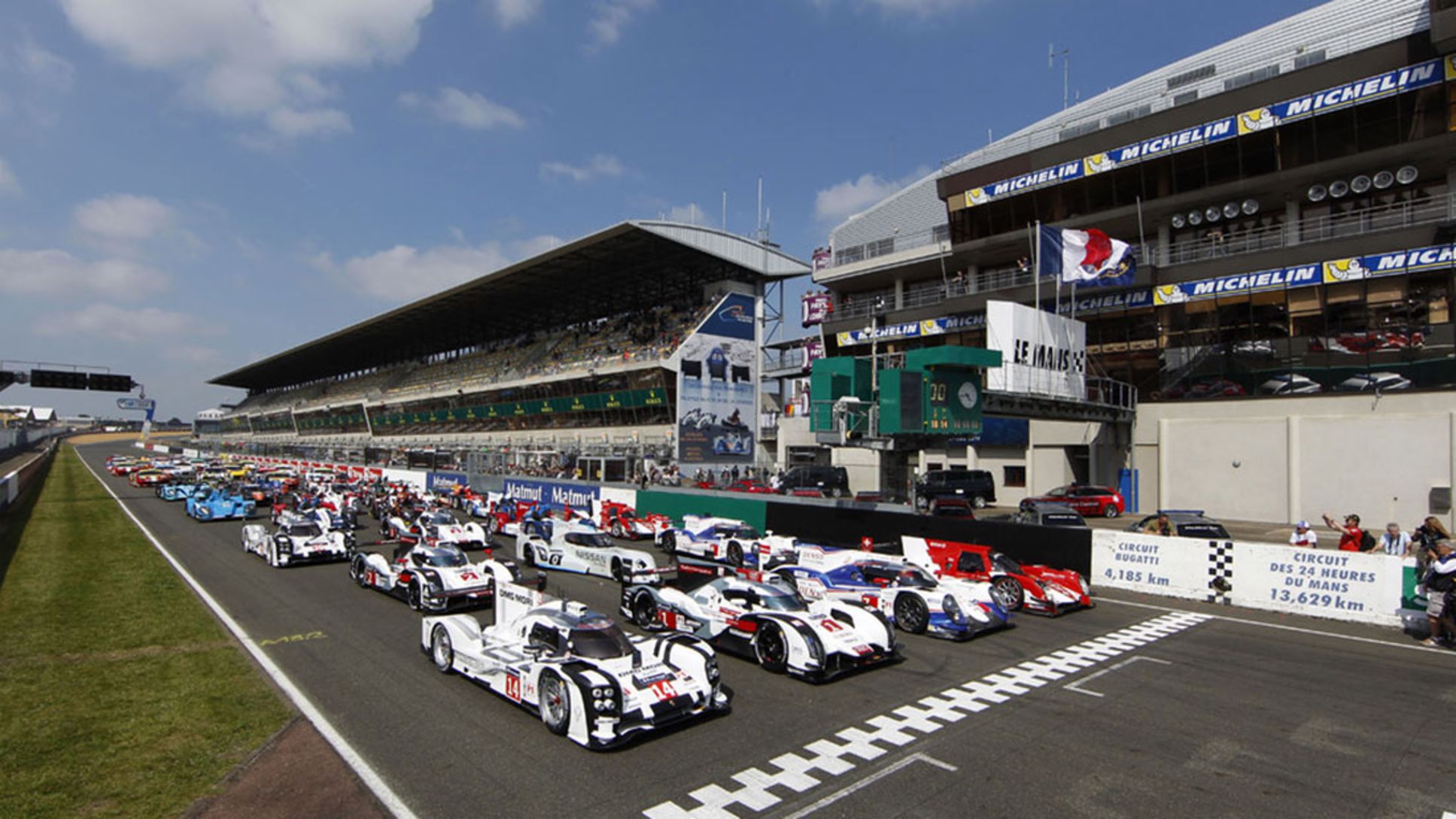After an absence of 16 years, Porsche will once again compete in the top category of what is certainly the world's toughest car race, which starts at 3:00 pm on June 14, 2014. Porsche is fielding its most innovative prototypes at the 24 hours of Le Mans. The two Porsche 919 Hybrid cars with start numbers 14 and 20 will be driven by two trios of drivers: Romain Dumas (France), Neel Jani (Switzerland), Marc Lieb (Germany) and Timo Bernhard (Germany), Brendon Hartley (New Zealand), Mark Webber (Australia). These six world-class drivers have between them a total of 37 appearances at Le Mans.
Despite being a record holder at Le Mans with 16 overall victories, this year the sports car manufacturer has no experience to benefit from. For the first year of the LMP1 project the target is to get one of the fast Porsche 919 Hybrids to the finish line at the marathon.
New know-how is something that no one can take away from Porsche
Fritz Enzinger, Vice President LMP1, is looking forward to the race: "Porsche is facing the biggest moment of the LMP1 project – its first start in the top category at Le Mans in 16 years. Whatever the results, we have successfully completed a lot of stages to get here." Above all, Porsche has established a strong, innovative engineering team in the Porsche Development Centre in Weissach. The new know-how generated in-house by the great efforts of all those involved is something that no one can take away from Porsche. "The pole position in Spa showed that the Porsche 919 Hybrid is fast, and, as newcomers, we earned respect for this achievement. I am very proud of this young team, which is as competent in its technology as it is in its drivers. I wish each individual the best of luck and success in this marathon."
Facts and figures about Porsche in Le Mans:
-
With 16 overall victories, Porsche is the record holder at Le Mans.
-
The first Porsche overall victory dates back to 1970 (Hans Herrmann/Richard Attwood in a 917 KH Coupé), and the last victory to date was on June 7, 1998 (Laurent Aiello/Allan McNish/Stéphane Ortelli in a Porsche GT1).
-
According to the official archives, 812 Porsche cars have raced at Le Mans, and that too is a record.
-
The fastest qualifying lap was driven by Hans-Joachim Stuck in 1985 in a Porsche 962 C (average speed 251.815 km/h). That record will likely stand for eternity, since chicanes installed in 1990 now break up the long Hunaudières straight.
-
The longest race distance was covered by Timo Bernhard/Romain Dumas/Mike Rockenfeller in 2010 in their overall victory for Audi, a total of 5,410.713 km (397 laps, average speed 225.45 km/h).
-
The Porsche 919 Hybrid car numbers 20 and 14 stand for the year of the return.
-
In qualifying (Wednesday and Thursday until midnight), every driver must run at least five laps in the dark. While WEC rules call for averaging the two fastest laps of two drivers (i.e. the mean of four lap times), the classic Le Mans method is to simply take the fastest lap driven with the car.
-
The Le Mans night is one of the shortest of the year: the sun sets on Saturday at 9:55 pm, and it rises again on Sunday at 5:53 am.
-
In normal racing mode (without any safety car periods), the Porsche 919 Hybrid must refuel every 13 to 14 laps.
-
Refuelling and wheel changing may only be made sequentially, not at the same time. Only two mechanics may work simultaneously when wheel changing. That takes a lot longer than in Formula One, for example.
-
Drivers are normally only changed when new tyres are needed.
-
Two fuel tank fills with one set of Michelin tyres are the absolute minimum; three should be standard, and sometimes it might even be possible to do four – an open issue and a tremendous challenge for the drivers.
-
During the race, no driver may drive for more than four hours within a six-hour period. No driver may drive for more than 14 of the 24 hours.
-
Due to the length of the circuit, there are three safety cars at Le Mans.
-
The equipment taken to the track – in addition to the two race cars – includes a spare chassis, six engines, five front gearboxes, five rear gearboxes, six front wings and six rear wings, 80 rims, over 100 radios and headsets.
-
The amount of electrical energy that a driver can use for what is known as boosting is limited. The Porsche 919 Hybrid may consume exactly 1.67 kilowatt hours (kWh) of electricity on each 13.629 km long lap.
-
In 2013, the Le Mans victor completed 348 laps. Over this distance, the 919 Hybrid would generate and utilise 581.2 kilowatt hours (kWh) from its energy recovery systems – an amount of electrical power that would light a 60-Watt incandescent light bulb for a full 9,687 hours. Or expressed differently: this amount of energy would power the new Volkswagen e-Golf, which is currently the most energy-efficient electric car in the compact class, over 4,576 kilometres – enough to drive one-way across the USA from New York to Los Angeles.
-
All in all, there is even more honour and glory to be won at Le Mans: twice as many points are awarded than in the other seven races for the World Endurance Championship (WEC) that are each six hours long.
-
In the WEC standings, the Porsche team with 36 points is currently behind Toyota (84) and ahead of Audi (28) after two of eight races.
-
The Porsche 919 Hybrid was designed and built at the Development Centre of Porsche AG in Weissach. 230 team members work there.
-
The core team of Porsche for LMP1 racing at the race circuit in Le Mans consists of 86 team members (engineers, mechanics, team management). Add to that personnel from communication and marketing, sponsoring and driver support.
-
For Le Mans week, supplies include well over 1,000 team shirts and other clothing.
-
The shopping list for food and refreshments for the team and the media hospitality area include: 50 boxes of salad, 50 kg of strawberries, 300 melons, 1.2 metric tonnes of meat, 500 kg of fish, 600 kg of noodles, 2,000 eggs and 1,100 loaves of bread.
-
While most of the team members catch some sleep during the night of the race whenever they have time and space, the drivers have beds in containers located behind the pit. It is impossible to get a quiet rest, sleep from exhaustion is more likely.
-
The organiser, the Automobile Club de l'Ouest (ACO), expects over 250,000 spectators at the race.


